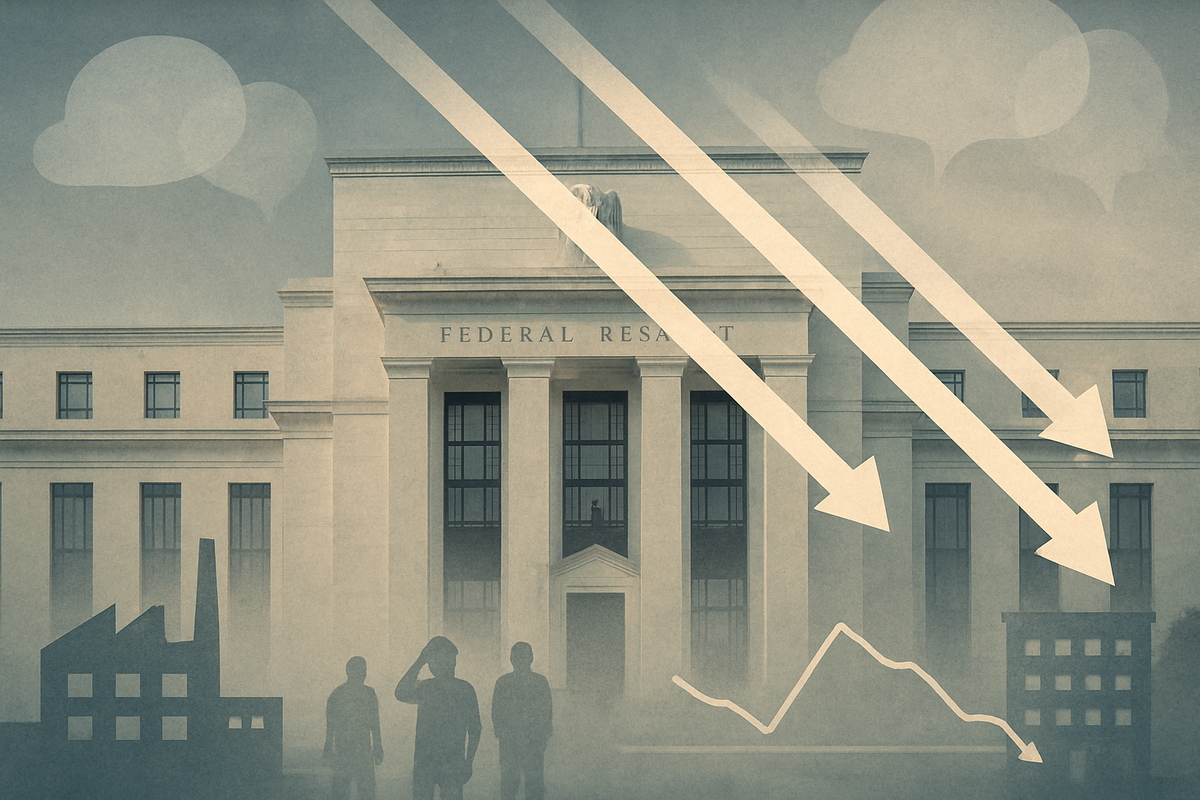
Washington D.C. – The Federal Reserve has sent clear signals of a continued dovish pivot, with Chair Jerome Powell indicating the likelihood of two additional quarter-point interest rate cuts before the close of 2025. This aggressive stance comes on the heels of a September rate reduction and is primarily driven by escalating concerns over a weakening U.S. labor market, even as inflation stubbornly persists above the central bank's target. The move underscores a significant re-prioritization of risks, with the Fed now seemingly more focused on shoring up employment prospects than on solely taming price pressures, a decision that highlights internal divisions among policymakers and sets the stage for a critical period for monetary policy and the broader economy.
The Fed's Pivotal Shift: Prioritizing Jobs Over Persistent Inflation
The Federal Reserve initiated its current easing cycle with a quarter-point cut to its benchmark interest rate in September 2025, bringing the target range to 4.0%-4.25%. This marked the first reduction of the year and signaled a notable shift in the Fed's assessment of economic risks. The decision was not made lightly, as evidenced by the minutes from the September Federal Open Market Committee (FOMC) meeting, released on October 8, 2025, which revealed a 10-9 split among officials regarding the appropriate path for monetary policy. While a majority supported the cut, a significant contingent expressed apprehension about persistent inflation, which remains elevated at approximately 2.9% in August, notably above the Fed's long-term 2% target.
However, on October 14, 2025, Federal Reserve Chair Jerome Powell delivered a pivotal speech at the National Association for Business Economics annual meeting in Philadelphia, solidifying the Fed's commitment to further easing. Powell explicitly stated that the Fed is likely on track to implement two more quarter-point interest rate cuts this year. Market participants are now keenly anticipating these reductions at the upcoming FOMC meetings, with strong expectations for a cut on October 29 and another in December. The CME FedWatch Tool currently reflects a 97% probability of a 25-basis-point cut in October and an 89% chance for a similar move in December, underscoring widespread market conviction. Powell reiterated that "rising downside risks to employment have shifted our assessment of the balance of risks," signaling that the health of the labor market has become the paramount concern. This re-evaluation comes as official economic data, including the crucial September jobs report, has been delayed due to an ongoing federal government shutdown, forcing the Fed to rely more heavily on private sector data and anecdotal evidence from its nationwide network of contacts. Beyond 2025, Fed projections suggest at least one additional interest rate cut in both 2026 and 2027, potentially bringing the federal funds rate to a range of 3% to 3.25%.
The primary catalyst for this accelerated easing trajectory is a discernible and accelerating deterioration in the U.S. labor market. Powell highlighted a "sharp slowdown in job creation" as a growing risk, a concern echoed by slowing payroll gains and even private data suggesting job losses in September. The national unemployment rate edged up to 4.3% in August 2025, the highest since October 2021, while unemployment among young U.S. workers (16-24) reached a concerning 10.5% in August, a near four-year high. Furthermore, consumer sentiment surveys, such as the University of Michigan's preliminary October 2025 index, show sustained pessimism about future job prospects, and the New York Fed's September Survey of Consumer Expectations indicates a deterioration in labor market outlooks, with lower expected earnings growth and higher probabilities of job loss. These indicators, coupled with a decline in labor force growth and softening wage increases, paint a picture of a labor market under significant duress, compelling the Federal Reserve to act decisively to prevent a deeper economic downturn.
Corporate Fortunes in a Lower-Rate Environment: Winners and Losers
The Federal Reserve's pivot towards interest rate cuts will inevitably reshape the landscape for various public companies and sectors, creating distinct beneficiaries and those facing renewed challenges. The overarching goal of stimulating economic activity and mitigating labor market weakness through cheaper borrowing costs will reverberate across industries.
Growth-oriented sectors, particularly Technology and Innovation, are poised to be significant winners. Lower interest rates reduce the cost of capital, making it more affordable for companies to fund research and development, expand operations, and pursue strategic investments. This is especially beneficial for firms that rely on future earnings potential, as lower discount rates applied to projected cash flows can significantly boost valuations. Tech giants like Amazon (NASDAQ: AMZN) and Apple (NASDAQ: AAPL), alongside specialized biotech and healthcare growth firms such as NeoGenomics (NASDAQ: NEO), Progyny (NASDAQ: PGNY), Repligen (NASDAQ: RGEN), Revvity (NYSE: RVTY), and Waters (NYSE: WAT), stand to gain from reduced debt servicing costs and more attractive valuations.
The Real Estate and Homebuilding sectors are also expected to see a significant tailwind. Cheaper mortgages directly translate to increased affordability for prospective homebuyers, stimulating demand, boosting refinancing activity, and invigorating the broader housing market. Major homebuilders like Pultegroup (NYSE: PHM), D.R. Horton (NYSE: DHI), and Lennar (NYSE: LEN) are direct beneficiaries. The ripple effect will extend to construction equipment suppliers such as Caterpillar (NYSE: CAT), building materials companies like Builders FirstSource (NYSE: BLDR) and Mohawk Industries (NYSE: MHK), and even real estate technology platforms like Zillow (NASDAQ: ZG). Similarly, capital-intensive Industrials and Utilities will benefit from lower financing costs for large-scale projects and infrastructure upgrades, with companies like NextEra Energy (NYSE: NEE) and Duke Energy (NYSE: DUK) finding it cheaper to fund their extensive networks.
Consumer Discretionary companies are also set to gain as lower rates typically translate to cheaper consumer loans, encouraging spending on non-essentials. Brands like Nike (NYSE: NKE), Disney (NYSE: DIS), Netflix (NASDAQ: NFLX), Airbnb (NASDAQ: ABNB), and Tesla (NASDAQ: TSLA), along with major retailers such as Target (NYSE: TGT), Walmart (NYSE: WMT), and Costco (NASDAQ: COST), could see a boost in demand. Moreover, Small-Cap Stocks, which are often more sensitive to interest rate fluctuations due to higher proportions of floating-rate debt, are likely to experience a more pronounced positive impact. Certain segments of the Financial Sector, particularly loan originators and investment banks, may also benefit from increased transaction volumes in mortgages, mergers and acquisitions, and initial public offerings, exemplified by firms like Goldman Sachs (NYSE: GS), FICO (NYSE: FICO), and Equifax (NYSE: EFX).
Conversely, broad Banks and Lending Institutions may face challenges due to potential compression of Net Interest Margins (NIMs). While loan demand might increase, the profitability squeeze occurs if deposit rates do not decline as rapidly as lending rates. Companies holding substantial cash reserves and Fixed-Income Investors will also see reduced income from their investments as yields on instruments like Treasuries and money market funds fall. Navigating this new rate environment will require strategic adjustments across the corporate landscape, with agility being key to capitalizing on opportunities and mitigating risks.
Wider Significance: A Delicate Balancing Act for the Economy
The Federal Reserve's strategic pivot towards interest rate cuts, even in the face of persistent inflation and internal dissent, carries profound wider significance for the U.S. and global economies. This move signals a deliberate attempt to engineer a "soft landing" by proactively addressing a weakening labor market, aiming to stimulate growth without reigniting inflationary spirals.
This policy shift aligns with broader industry trends seeking to capitalize on lower borrowing costs. Small businesses, in particular, are expected to benefit significantly, as reduced interest rates free up capital, improve cash flow, and encourage investments in expansion and technology, potentially fostering a renewed sense of optimism. Similarly, the industrial sector, including aerospace, defense, and power equipment, anticipates a boost in capital expenditure. The technology and growth-linked sectors, highly sensitive to interest rate changes, are poised for continued strong performance, with AI-related spending expected to remain a key driver of business investment. On the consumer front, lower rates on mortgages, auto loans, and credit cards could spur spending, although the immediate impact on mortgage affordability might be more gradual, given its correlation with longer-term bond yields. Globally, the anticipated weakening of the U.S. dollar in Q4 2025, driven by Fed rate cuts and increased hedging by cross-border investors, could support emerging market stocks and boost demand for local currency government bonds. Gold and other precious metals, often seen as safe havens in periods of monetary easing and potential currency debasement, are also favorably positioned.
However, the regulatory and policy landscape is also set to evolve in response to these monetary shifts. Bank directors will need to remain vigilant, adapting lending strategies to navigate narrower net interest margins, while regulators might prioritize systemic stability during M&A activities. The year 2025 could also see ongoing deregulation efforts, tax policy revisions, and changes in compliance requirements, potentially benefiting FinTech firms through relaxed oversight but also intensifying competition. The Fed's actions also create a complex dilemma for government policy, particularly concerning issues like tariffs, which have contributed to inflation and slowed the job market. Furthermore, financial stability will remain a core focus for regulators, ensuring banks can withstand shocks and manage interest rate risk, with concerns about asset bubbles potentially acting as a brake on further rate cuts. Clarity around crypto-asset activities and a more favorable regulatory framework for digital financial products are also anticipated in the coming year.
Historically, the Fed has navigated similar complex situations. The "mid-cycle adjustment" of 2019, where the Fed cut rates three times due to trade conflict concerns and potential unemployment risks despite existing inflation worries, offers a recent parallel. Other easing cycles, like that in July 1996, were also initiated to reduce unemployment, based on the view that the economy could sustain growth without reigniting inflation. These historical precedents, alongside periods of a divided FOMC, underscore the inherent challenges in balancing the Fed's dual mandate of maximum employment and price stability, especially when faced with conflicting economic signals. History also suggests that interest rate markets often underestimate the magnitude of future rate movements, particularly on the eve of potential economic downturns, implying that the current market expectations might be conservative if the labor market deterioration accelerates. The performance of asset classes in past easing cycles also provides a guide: in non-recessionary easing, riskier assets and gold tend to perform well, while in recessionary scenarios, U.S. Treasuries and gold typically outperform.
What Comes Next: Navigating a Shifting Economic Landscape
The path forward for the U.S. economy and financial markets will be largely dictated by the Federal Reserve's continued response to the evolving interplay of a weakening labor market and persistent inflation. In the short term, the market anticipates two more quarter-point interest rate cuts by the Fed before the end of 2025, likely in October and December, aiming to bring the federal funds rate into the 3.75%-4% range. This aggressive easing is a direct response to the sharp slowdown in job creation, with August seeing only 22,000 jobs added and the unemployment rate rising to 4.3%, signaling a clear prioritization of employment stability. However, the persistent annual inflation rate of 2.9% in August, above the Fed's 2% target, presents a significant challenge, further complicated by the delayed release of crucial economic data due to the ongoing government shutdown.
Looking into 2026 and beyond, current forecasts suggest interest rates could move closer to 3%, with at least one additional cut anticipated. Economic growth is projected to slow to below-trend levels (1.8-1.9% GDP growth), and the unemployment rate is expected to gradually creep up to around 4.8% by early 2026. While inflation is projected to moderate, it is expected to remain just above 3% through mid-2026 before easing towards the Fed's target. The internal division within the Federal Reserve remains a critical factor, with a significant minority advocating for a more cautious approach to rate cuts due to inflation concerns, highlighting the complex balancing act inherent in the Fed's dual mandate. Longer-term interest rates, such as the 10-year Treasury yield, are expected to remain more elevated, potentially above 4.1% through 2030, as some rate cuts are already priced in and inflation expectations persist.
For businesses, strategic adaptations are paramount. Lower borrowing costs present opportunities to reassess funding strategies, pursue expansion projects, and invest in equipment or inventory. However, the slowing economic growth and potential for a job market "nothing like the one we've known for the past decade" necessitate a focus on efficiency, cost management, and adapting to potential shifts in consumer spending. Companies must also navigate persistent tariffs and trade policy fluidity by building resilient supply chains and developing strategies to absorb or pass on costs. Continued robust investment in artificial intelligence (AI) and cloud computing is expected to be a key driver of business investment, offering avenues for growth even in a slower economic environment.
Investors, meanwhile, should consider phasing excess liquidity into diversified portfolios. In fixed income, medium-duration quality bonds are appealing, and bond ladders can help lock in income before rates fall further, though elevated longer-term yields will limit the full transmission of looser monetary policy. Equities, particularly growth-oriented mega-cap tech and financials with strong balance sheets and innovative products, may see further gains supported by lower rates, robust corporate earnings (especially with potential corporate tax cuts), and AI tailwinds. Diversification and risk management are crucial given the uncertainty, with precious metals and potentially cryptocurrencies acting as inflation hedges. Market opportunities include increased demand in rate-sensitive sectors, stronger corporate earnings, and potential boosts for emerging markets due to a weaker U.S. dollar. However, challenges include persistent inflation, a weakening labor market impacting consumer spending, government shutdown-induced data delays, policy uncertainty, and increased market volatility.
Three key scenarios could unfold: a Baseline (Soft Landing Attempt), where gradual cuts lead to below-trend growth, contained unemployment, and moderating inflation, supporting equities and offering bond income. A Deeper Slowdown/Mild Recession could emerge if labor market deterioration accelerates, forcing more aggressive Fed cuts and leading to greater equity volatility, with defensive assets outperforming. Finally, Stagflationary Pressures could arise if inflation remains stubbornly high alongside weak growth, creating a severe policy dilemma for the Fed and challenging equity markets, while favoring real assets and inflation-indexed securities. Businesses and investors must prepare for these diverse outcomes by maintaining agility and adapting their strategies to the evolving economic landscape.
MarketMinute Wrap-up: Navigating the Fed's Dovish Turn
The Federal Reserve's decisive pivot towards interest rate cuts marks a critical juncture for the U.S. economy and financial markets. The central bank, having initiated its easing cycle in September 2025 and signaling two more quarter-point reductions by year-end, is prioritizing the mitigation of a rapidly weakening labor market. This proactive "risk management" approach aims to preempt a more severe economic downturn, even as it navigates the complexities of persistent inflation, which remains above the Fed's 2% target, and notable divisions within the FOMC regarding the optimal policy path. The ongoing federal government shutdown, by delaying crucial economic data, adds another layer of uncertainty to an already intricate decision-making environment.
Moving forward, the market is broadly expected to react favorably to the prospect of lower borrowing costs. This environment typically encourages investment and consumer spending, providing a tailwind for various sectors. Global equities, including the S&P 500 and Nasdaq, have already shown resilience and upward momentum, partly in anticipation of these cuts. However, investors should heed Chair Powell's cautionary note regarding "fairly highly valued" equities, suggesting a need for discerning investment choices. While bond yields may decline, potentially impacting fixed-income returns, a weaker U.S. dollar could emerge, boosting American exports and attracting capital to emerging markets. The stimulated M&A activity also presents opportunities in the financial sector.
The lasting impact of this policy shift could be a period of sustained, albeit potentially moderate, economic growth, as the Fed attempts to rebalance its dual mandate objectives. However, the inherent tension between achieving full employment and price stability will undoubtedly remain a central challenge for policymakers. The duration and economic consequences of the government shutdown will also be a significant factor in shaping market confidence and the broader economic trajectory.
For investors in the coming months, vigilance is key. Closely monitor economic data, both official (once available) and alternative private sector reports, for insights into employment, wage growth, and consumer spending. Pay particular attention to core PCE inflation trends; sustained disinflation would grant the Fed more flexibility for cuts, while any acceleration could prompt a pause. Scrutinize all Fed communications, from FOMC statements to individual speeches, for cues on policy direction and internal consensus. The swift resolution of the government shutdown is crucial for reducing uncertainty. Finally, critically assess market valuations, especially in sectors that have experienced significant rallies, and consider opportunities in high cash flow-generating technology companies, particularly those involved in AI and cloud computing, as well as the financial sector. Maintaining a flexible and diversified portfolio strategy, balancing equity and fixed-income exposure, will be paramount in navigating this evolving economic landscape.
This content is intended for informational purposes only and is not financial advice







